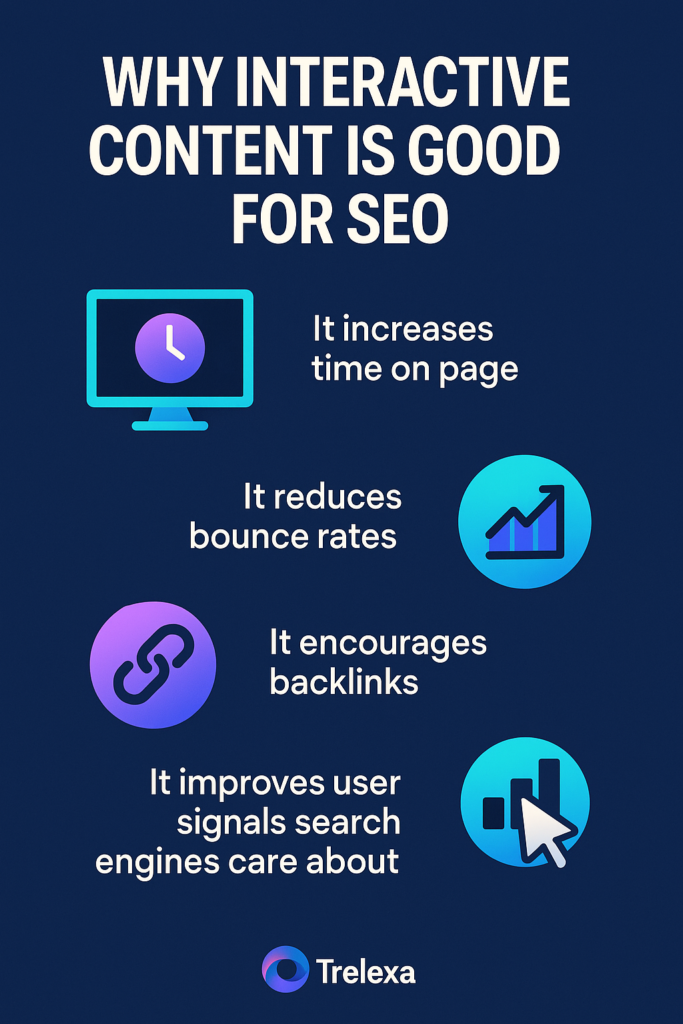Getting clicks is easy. Getting people to stay, scroll, and actually care? That’s the hard part.
Most SEO strategies still focus on rankings. Keywords. Metadata. Backlinks. And sure, those things matter. But they don’t tell the whole story. If your content doesn’t engage, search engines notice. So do your visitors.
That’s where interactive content starts to shift the game. Think calculators that help people estimate costs. Quizzes that personalize recommendations. Interactive maps that let users explore.
These are tools that keep people on the page longer, clicking more, and leaving with real value. And that’s exactly what search engines want.
In this blog, let’s talk about how interactive content can boost your SEO strategy. We’ll cover how it works, what to create, what to avoid, and how to do it in a way that actually helps your business.
What is interactive content?
Interactive content is any type of content that invites the user to take action — not just read, watch, or scroll, but to participate.
It turns the audience from passive observers into active users, which fundamentally changes how they experience your website.
At its core, interactive content is built for engagement. It might be a quiz, a calculator, a poll, a clickable infographic, or even a product recommendation tool.
The format doesn’t matter as much as the interaction itself — the key is that the user has to make choices, input information, or engage in some form of back-and-forth with the content.
It’s about function. Interactive content gives people something to do — and something to take away.
Why it’s different from static content
Static content is linear: you scroll through it or watch it from start to finish. It asks nothing of you. Interactive content flips that.
It creates moments of decision — small touchpoints where the user leans in instead of tuning out.
And that simple shift changes everything. It boosts engagement, improves retention, and gives you a much clearer sense of what your audience cares about based on how they interact.
Interactive content is part education, part experience — and that’s exactly why it works so well with SEO.
Why interactive content is good for SEO
Search engines may rank you, but it’s people who decide if you deserve to stay there.
Interactive content improves both sides of that equation — by keeping people engaged andsending the right signals to search engines.

It increases time on page
The longer someone stays on your site, the stronger the signal you send to Google that your content is worth their time.
A user who interacts with a quiz, explores a tool, or clicks through an interactive map naturally stays longer — because they’re actively engaged, not just skimming.
That added dwell time can give your page a serious edge over competitors with similar content.
It reduces bounce rates
When content is static, people often scan and leave. But when the page invites participation — a “Start the quiz” button, a sliding calculator, or a poll — they pause. They explore. They move deeper.
Fewer bounces tell search engines that your content matched the user’s intent — which helps improve your rankings over time.
It encourages backlinks
Useful interactive tools get shared.
Whether it’s an ROI calculator, a content idea generator, or a diagnostics quiz, these pieces often get picked up by bloggers, creators, and even journalists.
Unlike blog posts that are easy to replicate, good interactive content is harder to duplicate — making it a stronger backlink magnet.
It improves user signals search engines care about
Engaged users scroll more, click more, and interact more. Google notices.
These behavior-based signals help reinforce that your content is relevant, useful, and high-quality — especially when combined with strong internal linking and on-page SEO.
Types of interactive content that boost SEO
To move the SEO needle, the format needs to align with what your audience actually wants — and how they want to engage.
Here are the formats that consistently perform well when done right.
Quizzes and assessments
People love personalized insights — and quizzes deliver them in a way that feels fun, fast, and relevant.
Whether it’s “What type of entrepreneur are you?” or “Find the right product for your skin type,” quizzes drive clicks, shares, and engagement.
Bonus? They also help segment your audience and inform future content — a win beyond SEO.
Calculators and tools
These offer instant, actionable value.
Think: ROI calculators, cost estimators, savings tools, or “compare plans” sliders.
If your content can answer a question someone’s already Googling — and do it interactively — that tool will keep showing up in searches.
And when it’s genuinely helpful? People link to it. A lot.
Interactive infographics and maps
Interactive visuals let users control the experience.
That alone keeps them engaged longer.
Whether you’re showing demographic data by region or letting users click through a visual timeline, these assets combine visual appeal with depth — two ingredients search engines love.
Surveys and polls
Polls let users instantly weigh in — and make them feel heard.
Embedded surveys can also guide people to different content based on their responses.
The added interactivity keeps bounce rates low and gives you a fresh stream of user-driven data to build on.
Where most brands go wrong with interactive content
Interactive content can be a powerful SEO tool — but only if it’s built with purpose.
A slick interface doesn’t mean much if it doesn’t actually deliver value. Here’s where brands tend to misfire.
Focusing on gimmicks instead of usefulness
Not everything needs a slider. And a quiz without real insight feels empty fast. If your interactive content is there just to look good, it won’t hold attention — and it won’t help your SEO.
The best pieces solve real problems or offer something meaningful in return for a click.
Not optimizing for mobile
This one’s big. If your quiz doesn’t scale, if your calculator doesn’t load properly, or if your infographic gets cut off on a phone screen — users leave.
Mobile-first isn’t a suggestion anymore. It’s the default.
Ignoring accessibility and load speed
Animations that slow down your site? Text that’s unreadable for screen readers?
These aren’t just UX issues — they’re SEO problems.
Google penalizes slow, inaccessible pages. Interactive content must enhance the experience, not create roadblocks.
The takeaway? Don’t build it just because you can. Build it because it adds something your static content can’t.
Also read: Common SEO Mistakes Tanking Your Rankings
How Trelexa helps brands build SEO strategies that work
Most SEO agencies focus on rankings. At Trelexa, we focus on what happens after someone clicks.
We help brands design content that doesn’t just show up in search — it earns attention once it’s there. That includes interactive tools, quizzes, calculators, and visual experiences built to serve your audience and support your business goals.
Whether you’re trying to lower bounce rates, increase dwell time, or get more backlinks from assets worth sharing, we help you create interactive content that works. And we make sure it fits into a larger SEO strategy that puts relevance and engagement first.
Search engines reward substance. We help you deliver it.
Final thoughts
Ranking is only part of the game. What matters just as much is what people do once they land on your site.
Interactive content bridges that gap. It invites people to engage, stay longer, explore deeper, and leave with something useful.
That’s the kind of experience search engines want to rank — and users want to come back to.
If your current SEO strategy is focused only on keywords and technical fixes, you’re leaving a lot on the table. It’s time to build content people actually want to use.

